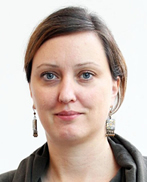Columbia University
Irving Medical Center
Neurological Institute
710 West 168th Street, 3rd floor
(212) 305-1818
Featured Research
In the Lab:
Marta Olah, PhD

Marta Olah, PhD
Phenotypical heterogeneity of microglia has been recognized since these neuroglia were first described by del Rio-Hortega a century ago. The cellular morphology-based assessment of their activation state has dominated the field ever since, and led to their implication in the pathogenesis of neurodegenerative diseases. This ‘guilt by association' view of microglial involvement in pathological changes affecting the central nervous system has endured despite paradigm shifts within the field. With the advent of genomics, the findings of genome wide association studies rekindled an interest in microglia in neurodegeneration, but also highlighted a lack of understanding of transcriptional and functional phenotypes microglia can acquire, particularly in human. Thanks to recent technological advances, it is now possible to explore the identity and heterogeneity of this enigmatic, shape-shifting, resident innate immune cell of the central nervous system (CNS) in a high throughput, unbiased fashion.
As a neuroimmunologist, my primary scientific focus lies in understanding the involvement of microglia in physiological and pathological processes in the CNS. Throughout my carrier my scientific investigations centered on microglia phenotypes; the ways through which they arise and can contribute to the maintenance of brain tissue homeostasis and to the outcome of disturbances therein. As a PhD candidate in the lab of Dr. Erik Boddeke (University of Groningen, The Netherlands), I investigated the microglia phenotypes associated with physiological plasticity and regenerative processes in mouse models of neurodegeneration. Furthermore, through establishing an optimized pipeline for the isolation of live microglia from postmortem human brain material, I explored the regional heterogeneity of microglia phenotypes in the human brain. Subsequently, as a postdoctoral research fellow at Harvard Medical School in the lab of Dr. Samia Khoury, I studied how neuroimmune interactions can shape the phenotype of microglia and their involvement in regeneration in demyelinating diseases. For my second postdoctoral fellowship, I joined the lab of Dr. Philip L. De Jager in order to be part of a multidisciplinary translational research group and to explore the involvement of microglia in homeostasis and age related neurodegenerative processes from a systems biological perspective. Following up on my interests that I developed during my PhD, I have optimized the microglia extraction pipeline to be suited for the use with aged and compromised human brain specimens. Using this approach, we were the first one to chart the transcriptomic landscape of aged human microglia.
The focus of my current research is to explore the extrinsic and cell autonomous factors that shape the function and phenotype of human microglia, and to understand how the resulting changes in the population structure of microglia contribute to the pathogenesis and progression of neurodegenerative diseases. Under the guidance of Dr. De Jager in the Taub Institute and the Center for Translational and Computational Neuroimmunology, and in collaboration with Dr. Vilas Menon, we recently described several transcriptionally distinct microglia subsets in the aged human brain, by means of single cell RNA sequencing.
Using this approach, with the help of Taub and Neurology collaborators Drs. Andrew Teich, Roy Alcalay, Edward Huey and Neil Shneider, we are further exploring the population structure of human microglia in neurodegenerative diseases such as Alzheimer's disease (AD), Parkinson's disease (PD), multiple sclerosis (MS), frontotemporal dementia (FTD), and amyotrophic lateral sclerosis (ALS). The ultimate aim of these studies is to generate an atlas of states microglia can acquire in the human CNS, in health and disease.
As a next step, we employ a series of complementary ex vivo, in situ and in vitro approaches to profile the identified human microglia subsets at the transcriptomic, proteomic, epigenetic (in collaboration with Dr. Falak Sher), and functional level. This approach has recently led to the identification of a protective microglia subset that is diminished in the brain of AD patients, and to identify candidate microglia subsets that could be involved in the pathogenesis of ALS.
Marta Olah, PhD
Instructor in Neurology (in the Taub Institute for Research on Alzheimer's Disease and the Aging Brain) at the Columbia University Medical Center
mo2738@cumc.columbia.edu

